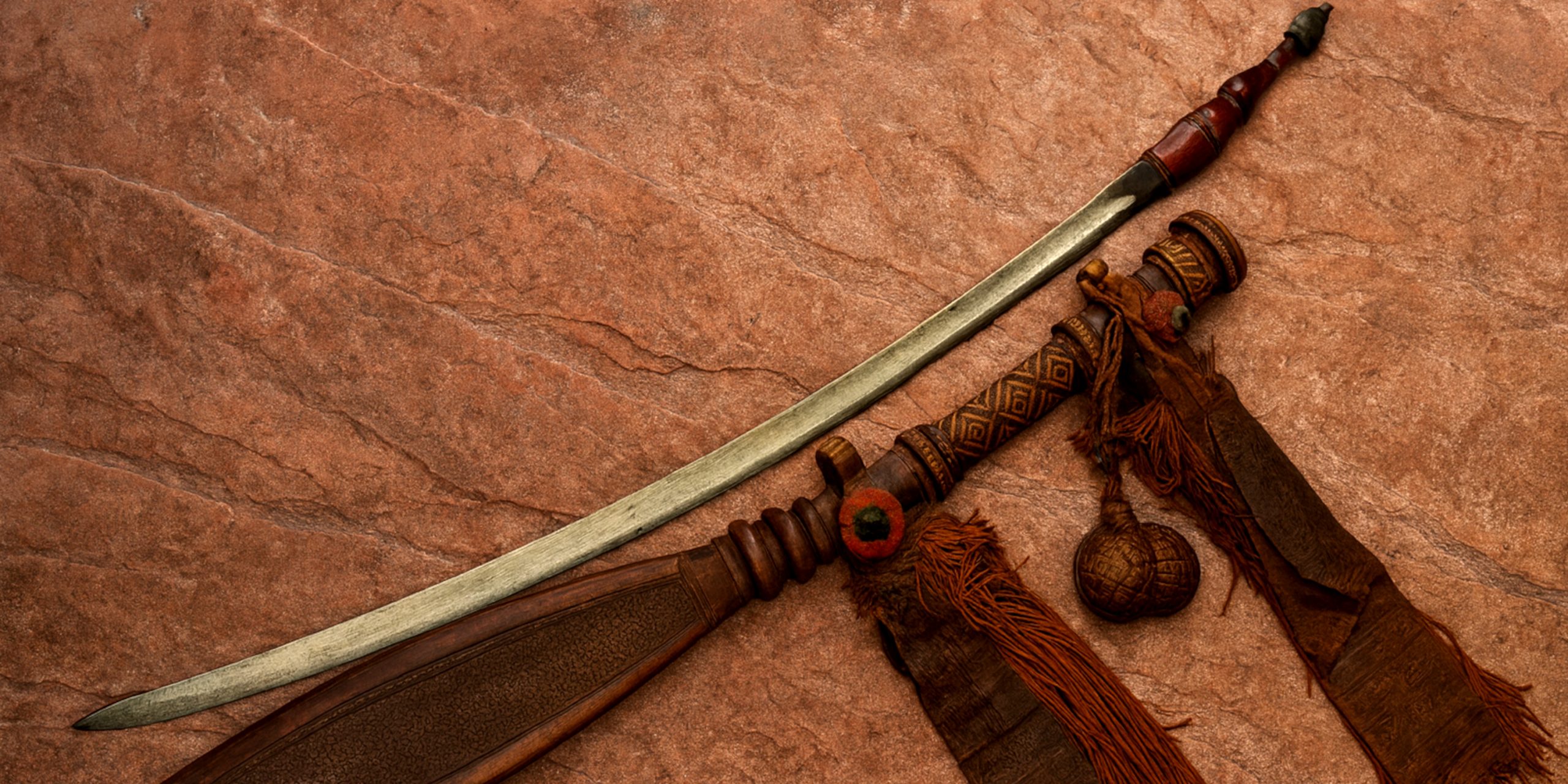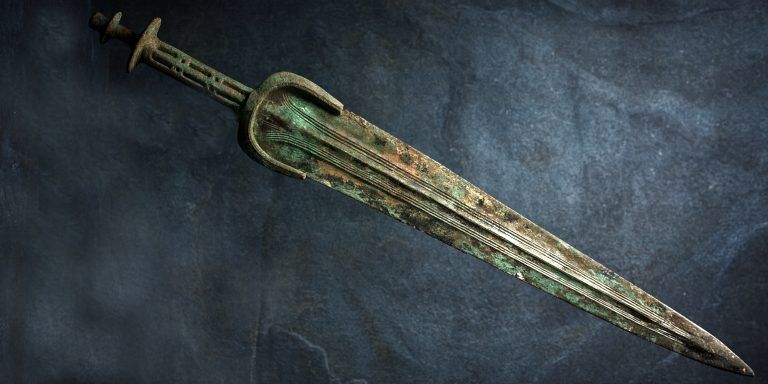
The Mandinka sword, also known as the Manding or Mandingo sword, is associated with Mandinka and other Mande-speaking communities across Mali, Guinea, Sierra Leone, The Gambia and Senegal. Surviving examples date mainly to the nineteenth and early twentieth centuries. Rather than a single blade form, it is best recognised by its leather craftsmanship: a leather-bound hilt and an elaborately tooled scabbard, sometimes resembling reptile skin. Both locally forged and imported European blades were mounted in this distinct Mandinka style.
Key Specifications
| Feature | Typical Range / Notes |
|---|---|
| Overall length | 90–100 cm on sabre-type examples; ceremonial pieces 55–65 cm |
| Blade length | 65–85 cm for fighting sabres; some shorter examples 44–75 cm |
| Blade form | Curved single-edged sabres are common; straight single-edged blades also occur; often with fullers |
| Hilt | Wooden or full tang core, leather-bound grip, small crosspiece, occasional brass fittings |
| Scabbard | Heavy, tooled leather with geometric panels, plaited seams, sometimes coloured |
| Materials | Iron or steel blade; leather, brass, and plant fibres |
| Cultural attribution | Mandinka (Malinke/Manding) peoples, western Sudan belt |
Distinctive Features
- Leather-wrapped grip with precise seam and stamped tooling
- Thick leather scabbard decorated in geometric panels
- Mixed blade sources: local forge-welded or re-used European cavalry blades
- Some examples feature triple fullers or hatchet points
History and Evolution
Mandinka blacksmiths played a key role in military equipment across the Mande world. During the nineteenth century, trade expanded blade supply: imported European cavalry blades were frequently re-hilted with Mandinka fittings. The craftsmanship of leatherwork became an important marker of status, particularly among Muslim elites in coastal trade hubs. By the late nineteenth century, collectors and museums identified these swords as Malinke or Mandingo, and ceremonial versions persisted into the twentieth century.
Advantages
- Durable leatherwork provided protection for the blade in humid climates
- Flexibility of blade supply allowed local and imported steel to be adapted
- Tooling and decoration conveyed wealth and social rank
Disadvantages
- Inconsistent blade quality due to varied sources
- Overlapping features with neighbouring sword types make attribution difficult
- Leather fittings are vulnerable to drying, mould, and damage if not preserved properly
Comparison with Similar Weapons
| Feature | Mandinka Sword | Takouba (Tuareg/Hausa) | Kaskara (Sudan) | Nimcha (Maghreb) |
|---|---|---|---|---|
| Blade | Curved or straight, single edge, often fullered | Straight, double edged | Straight, double edged | Curved sabre |
| Hilt | Leather-clad, small guard | Flat crossguard with spacers | Broad crossguard with leather wrapping | Open S-guard with knucklebow |
| Scabbard | Tooled leather panels | Leather with geometric tooling, metal fittings | Long leather scabbard with triple rings | Velvet or leather, metal chapes |
| Region | West Africa (Mali, Guinea, Sierra Leone, Gambia, Senegal) | Sahara and Sahel | Sudan and Chad belt | Morocco, Algeria, Tunisia |
| Key trait | Leather craftsmanship and tooling | Distinctive squared guard | Triple ring suspension | S-shaped guard silhouette |
Legacy
The Mandinka sword reflects the fusion of African leatherwork and adaptable use of both local and foreign blades. It was not only a weapon but also a prestige item tied to identity, rank, and Islamic cultural expression in the western Sudan belt. Today it occupies a place in museum collections and in the collector market, bridging martial function with artful design.
Where to See Examples
- Major museums such as the Metropolitan Museum of Art (New York) hold nineteenth-century Mandinka swords with full scabbards.
- Regional museums in Sierra Leone display examples identified as Mandingo leatherwork.
Collector’s Guide
Dating and Identification
- Earlier examples: long fighting sabres, often plain leatherwork, sometimes mounted with imported European blades
- Later examples: shorter, more decorative, ceremonial in function
- Check for original tooled leather, full patina, and signs of age-consistent wear
Condition Factors
- Red rust around the tang or guard is a concern
- Mould or cracking leather requires careful conservation
- Modern reproductions may show machine stitching, fresh dyes, or riveted parts
Auction and Market Prices
- Entry level: £60–£150 (later or tourist examples)
- Mid range: £200–£500 (complete swords with scabbards in fair condition)
- High grade: £800–£1,500+ (museum-quality examples with fine tooling and provenance)
What Adds Value
- Original scabbard with intact tooling
- Evidence of re-hilted European blade in authentic context
- Clear provenance and comparison with museum-catalogued examples



